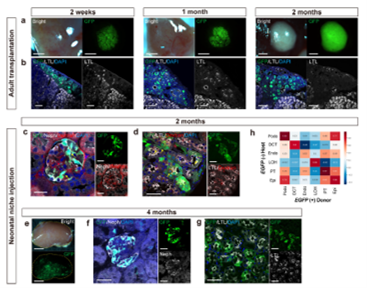- TEL:
- +81-3-5462-4831
- FAX:
- +81-3-5462-4835
※9:00-17:40 Mon.-Fri. (JST)



Kenji Matsui, Shuichiro Yamanaka, Sandy Chen, Naoto Matsumoto, Keita Morimoto, Yoshitaka Kinoshita, Yuka Inage, Yatsumu Saito,
Tsuyoshi Takamura, Toshinari Fujimoto, Susumu Tajiri, Kei Matsumoto, Eiji Kobayashi and Takashi Yokoo
Commun Biol 6, 1097 (2023). https://doi.org/10.1038/s42003-023-05484-9
Copyright © Authors 2023
This article is licensed under a Creative Commons Attribution 4.0 International License (CC BY).
Organoids have garnered attention as tools for evaluating developmental and pathological models. Kidney organoids generated in vitro can mature by receiving blood supply from the host mouse after transplantation. However, the lack of connection to the urinary tract limits their long-term viability. Establishing a connection between exogenous nephrons and the host urinary tract would extend their viability and enhance their clinical utility as a kidney model in which functionality and response to nephrotoxicity can be assessed.
|
In this study, the group has developed the neonatal niche injection (NNI) method. This method proved to be highly approachable for generating chimeric nephrons by injecting renal progenitor cells (RPCs) and RPC spheroids produced by PrimeSurfaceTM into neonatal mice. These chimeric nephrons with a connection to the host urinary tract exhibit maturation levels comparable to host nephrons, remain viable over an extended period, and are valuable for evaluating nephrotoxicity. Furthermore, hiPSC-derived progenitor cells also differentiate into nephrons using this method. |

|
| Cat # | Product name | Well | Color | Bottom design | Well Vol | Package |
|---|---|---|---|---|---|---|
| MS-9096UZ | PrimeSurface™ 96U | 96 | Transparent | U bottom | 300 μL | Individual packaging 20 plates per case |
| MS-9096VZ | PrimeSurface™ 96V | 96 | Transparent | V bottom | 300 μL | Individual packaging 20 plates per case |
Remark